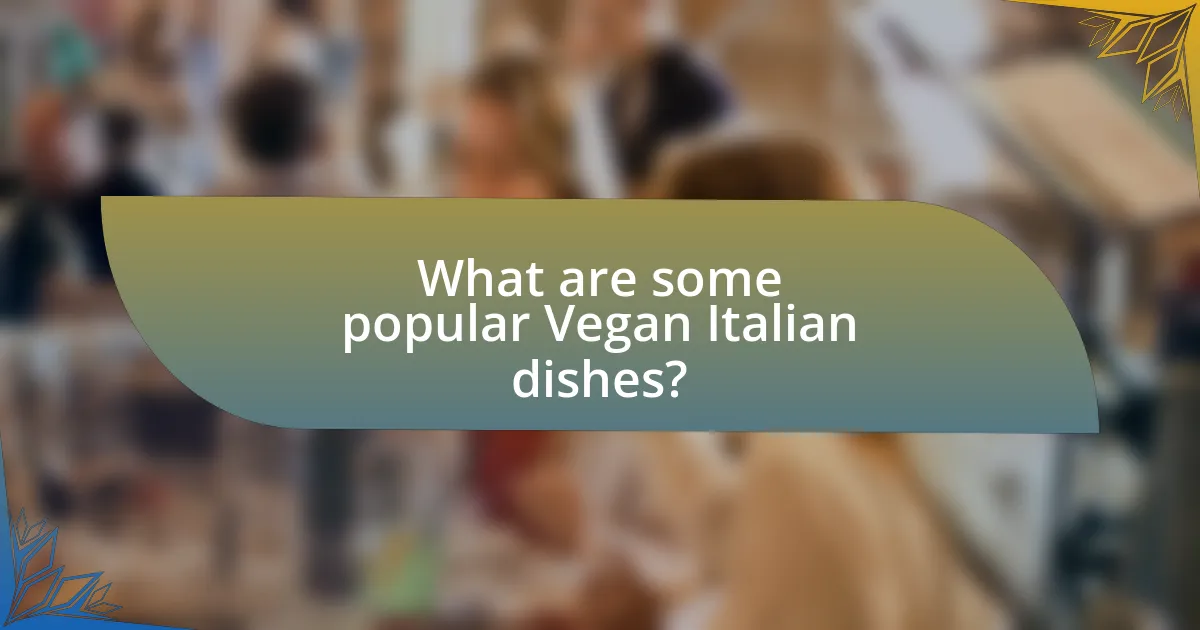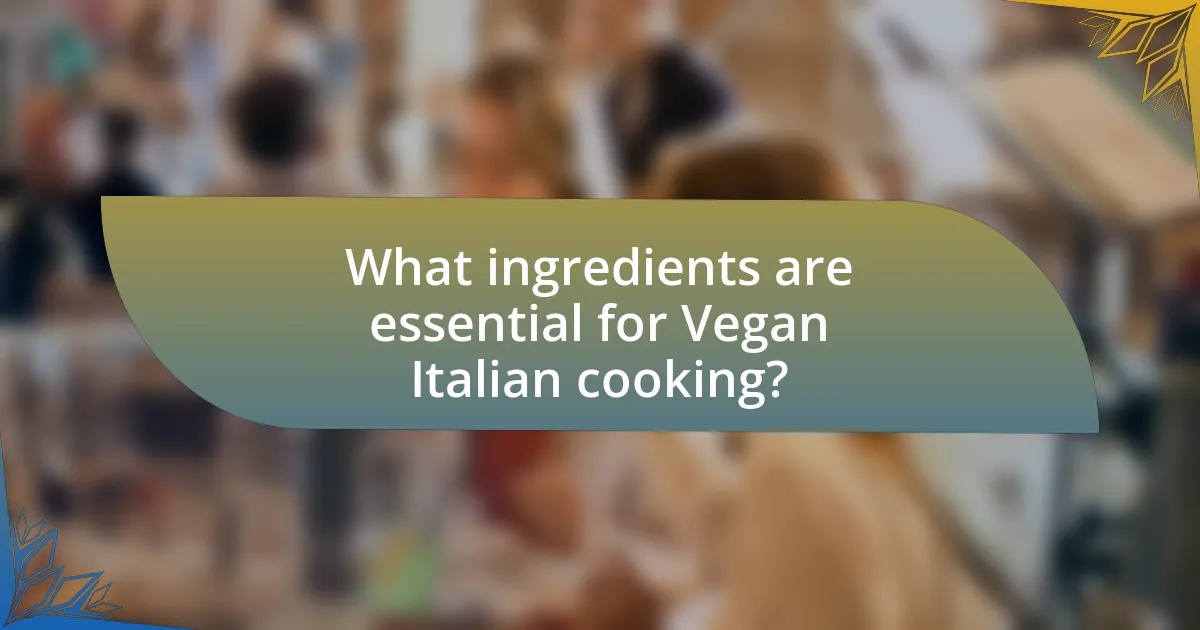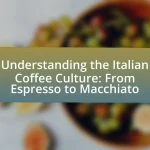Vegan Italian cuisine is a plant-based adaptation of traditional Italian dishes that excludes all animal products while preserving authentic flavors. This article explores the key differences between vegan and traditional Italian cuisine, highlighting essential ingredients such as tomatoes, garlic, and fresh herbs, as well as innovative cooking techniques that enhance flavor without meat or dairy. It also discusses the growing popularity of vegan Italian dishes due to health benefits, sustainability, and the versatility of plant-based ingredients. Additionally, the article provides practical tips for preparing vegan pasta, sauces, and appetizers, along with common mistakes to avoid in vegan Italian cooking.

What is Vegan Italian Cuisine?
Vegan Italian cuisine is a plant-based interpretation of traditional Italian dishes, eliminating all animal products while maintaining authentic flavors and ingredients. This culinary approach utilizes vegetables, legumes, grains, nuts, and plant-based alternatives to create meals that reflect the rich heritage of Italian cooking. For example, vegan pasta dishes often incorporate sauces made from tomatoes, garlic, and herbs, while vegan pizzas use dairy-free cheese and a variety of vegetable toppings. The growing popularity of veganism has led to an increase in innovative recipes that honor classic Italian flavors without compromising dietary choices.
How does Vegan Italian Cuisine differ from traditional Italian cuisine?
Vegan Italian cuisine differs from traditional Italian cuisine primarily by excluding all animal products, including meat, dairy, and eggs. Traditional Italian dishes often rely on ingredients like cheese, meats, and eggs for flavor and texture, while vegan Italian cuisine substitutes these with plant-based alternatives such as nutritional yeast, tofu, and various vegetables. For example, a traditional lasagna contains layers of pasta, ricotta, and meat, whereas a vegan version uses layers of pasta, cashew-based cheese, and vegetables. This shift not only alters the ingredient composition but also caters to dietary preferences and ethical considerations surrounding animal welfare and health.
What are the key ingredients in Vegan Italian Cuisine?
The key ingredients in Vegan Italian Cuisine include tomatoes, garlic, olive oil, fresh herbs, legumes, grains, and a variety of vegetables. Tomatoes serve as a base for sauces and soups, while garlic adds depth of flavor. Olive oil is essential for cooking and dressing dishes. Fresh herbs like basil and oregano enhance the taste of many recipes. Legumes, such as lentils and chickpeas, provide protein, and grains like pasta and rice are staples in many Italian meals. A wide range of vegetables, including zucchini, eggplant, and bell peppers, contribute to the diversity and nutrition of vegan dishes. These ingredients reflect traditional Italian cooking while adhering to a plant-based diet.
How do cooking techniques vary in Vegan Italian Cuisine?
Cooking techniques in Vegan Italian Cuisine often vary from traditional methods by substituting animal products with plant-based alternatives, emphasizing techniques like sautéing, roasting, and simmering to enhance flavors without meat or dairy. For instance, instead of using butter, olive oil is commonly employed for sautéing vegetables, while cashew cream or nutritional yeast can replace cheese in sauces, providing a creamy texture and umami flavor. Additionally, traditional pasta dishes may incorporate whole grain or legume-based pasta, which alters cooking times and methods. These adaptations not only maintain the essence of Italian cuisine but also cater to a plant-based diet, ensuring that flavors and textures remain rich and satisfying.
Why is Vegan Italian Cuisine gaining popularity?
Vegan Italian cuisine is gaining popularity due to the increasing consumer demand for plant-based diets and the health benefits associated with them. Studies indicate that a plant-based diet can reduce the risk of chronic diseases, leading more individuals to explore vegan options. Additionally, the versatility of traditional Italian dishes allows for easy adaptation to vegan ingredients, making it appealing to both vegans and non-vegans alike. The rise of social media and food blogs has also contributed to the visibility and accessibility of vegan Italian recipes, further driving interest and experimentation in this culinary niche.
What health benefits are associated with Vegan Italian Cuisine?
Vegan Italian cuisine offers numerous health benefits, including lower cholesterol levels, reduced risk of chronic diseases, and improved digestion. The emphasis on plant-based ingredients such as vegetables, legumes, and whole grains contributes to a diet rich in fiber, vitamins, and antioxidants. Research indicates that diets high in plant foods can lower the risk of heart disease by up to 32% and reduce the likelihood of developing type 2 diabetes. Additionally, the Mediterranean diet, which includes many vegan Italian dishes, has been linked to better gut health due to its high fiber content, promoting beneficial gut bacteria.
How does Vegan Italian Cuisine contribute to sustainability?
Vegan Italian cuisine contributes to sustainability by significantly reducing the environmental impact associated with traditional animal agriculture. Plant-based ingredients, which form the foundation of vegan Italian dishes, require less water and land compared to animal products; for instance, producing one pound of beef requires approximately 1,800 gallons of water, while growing vegetables typically requires far less. Additionally, the cultivation of plant-based foods generates lower greenhouse gas emissions, with studies indicating that a vegan diet can reduce an individual’s carbon footprint by up to 50%. By prioritizing ingredients like grains, legumes, and vegetables, vegan Italian cuisine promotes biodiversity and supports sustainable farming practices, further enhancing its positive impact on the environment.

What are some popular Vegan Italian dishes?
Popular vegan Italian dishes include pasta primavera, which features seasonal vegetables tossed with pasta, and marinara sauce, a tomato-based sauce that is naturally vegan. Another dish is risotto made with vegetable broth and various vegetables, providing a creamy texture without dairy. Additionally, caponata, a Sicilian eggplant dish, is often served as a side or appetizer and is entirely plant-based. These dishes are widely recognized in vegan Italian cuisine for their flavor and adherence to plant-based ingredients.
How can I make Vegan Pasta dishes?
To make vegan pasta dishes, start by selecting plant-based pasta, such as those made from whole wheat, lentils, or chickpeas. Cook the pasta according to package instructions, typically boiling in salted water for 8-12 minutes. For the sauce, sauté garlic and onions in olive oil, then add vegetables like spinach, bell peppers, or mushrooms. Incorporate canned tomatoes or a plant-based cream for a rich sauce. Season with herbs like basil, oregano, and salt. Combine the cooked pasta with the sauce, mix well, and serve. This method is validated by the versatility of plant-based ingredients, which can create a variety of flavors and textures in vegan cuisine.
What are some easy Vegan Pasta recipes to try?
Some easy vegan pasta recipes to try include Spaghetti Aglio e Olio, which consists of spaghetti tossed with garlic, olive oil, and red pepper flakes, and Penne Arrabbiata, made with penne pasta in a spicy tomato sauce. Another option is Vegan Pesto Pasta, where basil pesto is blended with nutritional yeast and tossed with your choice of pasta. Additionally, you can prepare a Creamy Vegan Alfredo using cashews blended with garlic and nutritional yeast for a rich sauce. These recipes are simple, require minimal ingredients, and can be prepared in under 30 minutes, making them accessible for quick meals.
How can I create a Vegan sauce for Pasta?
To create a vegan sauce for pasta, blend together cooked tomatoes, garlic, olive oil, and fresh basil. This combination results in a flavorful marinara sauce that is entirely plant-based. The tomatoes provide essential vitamins like vitamin C and antioxidants, while garlic adds flavor and potential health benefits such as improved immune function. Olive oil contributes healthy fats, making this sauce not only delicious but also nutritious.
What are traditional Vegan Italian appetizers?
Traditional vegan Italian appetizers include bruschetta, which consists of grilled bread topped with tomatoes, basil, and olive oil; caponata, a Sicilian eggplant dish with tomatoes, celery, and olives; and arancini, rice balls filled with vegetables and herbs. These appetizers reflect the rich flavors of Italian cuisine while adhering to a plant-based diet. Bruschetta dates back to the 15th century and is a staple in Italian cuisine, showcasing the use of fresh ingredients. Caponata has historical roots in Sicily, often served as a sweet and sour dish, highlighting the versatility of vegetables. Arancini, originating from Sicily, are traditionally made with risotto and can be filled with various vegetables, making them a popular choice for vegan adaptations.
Which Vegan alternatives can replace traditional Italian appetizers?
Vegan alternatives that can replace traditional Italian appetizers include bruschetta made with tomato and basil on toasted bread, vegan caprese salad using plant-based mozzarella, and stuffed mushrooms filled with a mixture of nuts and herbs. These options maintain the essence of Italian flavors while being entirely plant-based. For instance, bruschetta offers a fresh taste similar to the classic version, while vegan mozzarella can be made from cashews or almonds, providing a creamy texture akin to dairy cheese. Stuffed mushrooms not only deliver umami but also serve as a hearty, satisfying choice, showcasing the versatility of plant-based ingredients in Italian cuisine.
How can I prepare Vegan Bruschetta?
To prepare Vegan Bruschetta, start by dicing ripe tomatoes and mixing them with minced garlic, fresh basil, olive oil, balsamic vinegar, salt, and pepper. This mixture creates a flavorful topping. Next, slice a baguette or Italian bread, toast the slices until golden brown, and then top each slice with the tomato mixture. The combination of fresh ingredients and toasted bread results in a classic Italian appetizer.

What ingredients are essential for Vegan Italian cooking?
Essential ingredients for Vegan Italian cooking include tomatoes, garlic, olive oil, fresh herbs, nutritional yeast, and plant-based proteins such as lentils or chickpeas. Tomatoes serve as a base for sauces and soups, while garlic adds depth of flavor. Olive oil is crucial for cooking and dressing dishes. Fresh herbs like basil and oregano enhance the aroma and taste of Italian recipes. Nutritional yeast provides a cheesy flavor without dairy, and plant-based proteins contribute essential nutrients and texture to meals. These ingredients are foundational in creating authentic and flavorful vegan Italian dishes.
What plant-based substitutes can be used in Vegan Italian recipes?
Plant-based substitutes for Vegan Italian recipes include nutritional yeast for cheese, cashew cream for creamy sauces, and lentils or chickpeas as meat alternatives. Nutritional yeast provides a cheesy flavor and is rich in B vitamins, making it a popular choice in vegan cooking. Cashew cream, made by blending soaked cashews with water, creates a rich and creamy texture that can replace dairy in sauces and soups. Lentils and chickpeas serve as excellent protein sources, mimicking the texture of meat in dishes like Bolognese or meatballs. These substitutes effectively maintain the traditional flavors and textures of Italian cuisine while adhering to a vegan diet.
How can I replace cheese in Vegan Italian dishes?
To replace cheese in Vegan Italian dishes, use plant-based alternatives such as nutritional yeast, cashew cheese, or tofu-based ricotta. Nutritional yeast provides a cheesy flavor and is rich in B vitamins, making it a popular choice for vegan cooking. Cashew cheese, made by blending soaked cashews with lemon juice and spices, mimics the creaminess of traditional cheese. Tofu-based ricotta, created by crumbling firm tofu and mixing it with herbs and nutritional yeast, offers a similar texture to ricotta cheese. These alternatives effectively enhance the flavor and texture of Vegan Italian dishes while maintaining a plant-based profile.
What are the best plant-based proteins for Vegan Italian meals?
The best plant-based proteins for Vegan Italian meals include lentils, chickpeas, quinoa, and tofu. Lentils are rich in protein and fiber, making them ideal for hearty dishes like lentil bolognese. Chickpeas provide a versatile protein source, perfect for making creamy hummus or adding to pasta salads. Quinoa is a complete protein, containing all nine essential amino acids, and works well in salads or as a base for grain bowls. Tofu, a soy-based protein, can be marinated and used in various Italian recipes, such as vegan lasagna or stir-fries. These proteins not only enhance the nutritional profile of Vegan Italian meals but also contribute to the flavor and texture of traditional dishes.
How do herbs and spices enhance Vegan Italian cuisine?
Herbs and spices significantly enhance Vegan Italian cuisine by adding depth, flavor, and aroma to plant-based dishes. For instance, basil, oregano, and rosemary are commonly used in Italian cooking, providing a robust flavor profile that complements ingredients like tomatoes and olive oil. Research indicates that herbs and spices not only elevate taste but also contribute health benefits, such as anti-inflammatory properties found in garlic and antioxidants in oregano. This combination of flavor enhancement and health benefits makes herbs and spices essential in creating satisfying and nutritious Vegan Italian meals.
Which herbs are commonly used in Vegan Italian cooking?
Commonly used herbs in Vegan Italian cooking include basil, oregano, parsley, thyme, and rosemary. These herbs are essential for flavoring dishes such as pasta sauces, salads, and vegetable preparations. For instance, basil is a key ingredient in pesto, while oregano is frequently used in tomato-based sauces. The use of these herbs not only enhances the taste but also aligns with traditional Italian culinary practices, making them integral to authentic vegan recipes.
How can spices elevate the flavor of Vegan Italian dishes?
Spices can significantly elevate the flavor of Vegan Italian dishes by enhancing the overall taste profile and adding depth to plant-based ingredients. For instance, herbs like basil and oregano provide aromatic qualities that are essential in traditional Italian cuisine, while spices such as red pepper flakes introduce heat and complexity. The use of garlic and onion powder can also amplify savory notes, making dishes more satisfying. Research indicates that spices not only enhance flavor but can also contribute to health benefits, such as anti-inflammatory properties found in turmeric and antioxidant effects from oregano. This combination of flavor enhancement and health benefits makes spices a crucial component in creating delicious Vegan Italian dishes.
What tips can help me succeed in Vegan Italian cooking?
To succeed in Vegan Italian cooking, focus on using fresh, high-quality ingredients and traditional Italian flavors. Incorporating seasonal vegetables, herbs like basil and oregano, and plant-based alternatives for cheese and meat can enhance authenticity. For instance, nutritional yeast can provide a cheesy flavor, while lentils or mushrooms can serve as meat substitutes. Additionally, mastering techniques such as making homemade pasta with flour and water or preparing rich sauces like marinara from scratch can elevate your dishes. These practices align with the essence of Italian cuisine, which emphasizes simplicity and quality.
How can I ensure my Vegan Italian dishes are flavorful?
To ensure your Vegan Italian dishes are flavorful, focus on using fresh herbs, high-quality ingredients, and umami-rich components. Fresh basil, oregano, and parsley enhance the taste profile, while ingredients like sun-dried tomatoes, nutritional yeast, and miso paste provide depth and richness. Studies show that umami flavors can significantly enhance the overall perception of taste, making dishes more satisfying. Additionally, incorporating a variety of textures through roasted vegetables or crunchy nuts can elevate the dining experience.
What common mistakes should I avoid when cooking Vegan Italian cuisine?
Common mistakes to avoid when cooking Vegan Italian cuisine include neglecting to use high-quality ingredients, which can significantly impact flavor. For instance, using subpar olive oil or canned tomatoes can lead to a lackluster dish. Additionally, failing to balance flavors, such as not incorporating enough acidity or seasoning, can result in bland meals. Overcooking pasta is another frequent error; it should be cooked al dente to maintain texture. Lastly, not experimenting with herbs and spices, which are essential in Italian cooking, can lead to uninspired dishes. These mistakes can diminish the authenticity and enjoyment of Vegan Italian cuisine.















